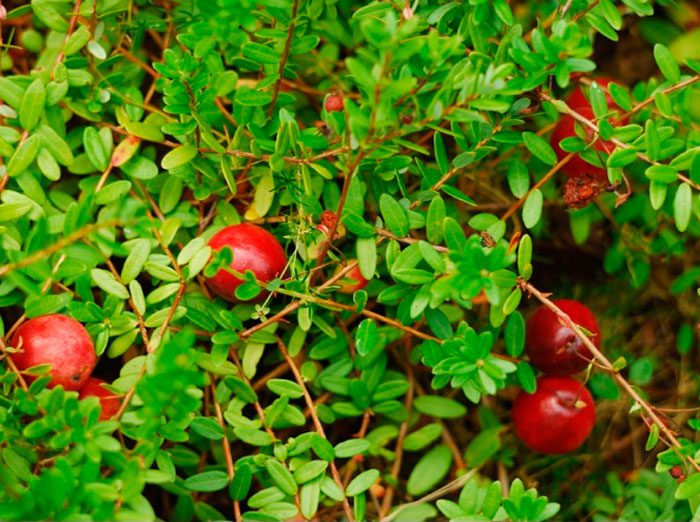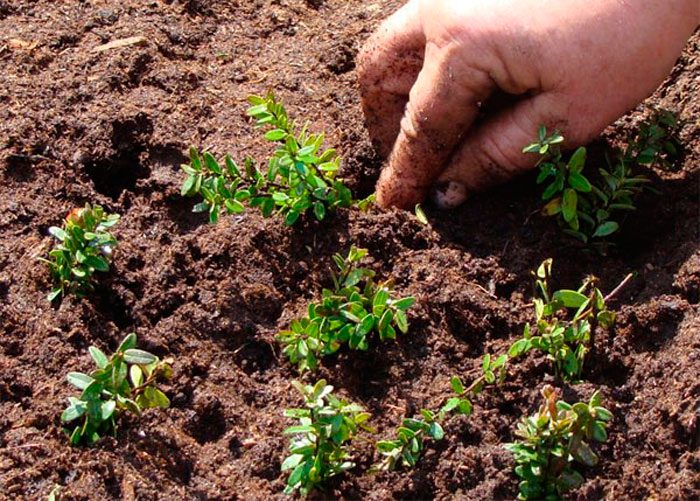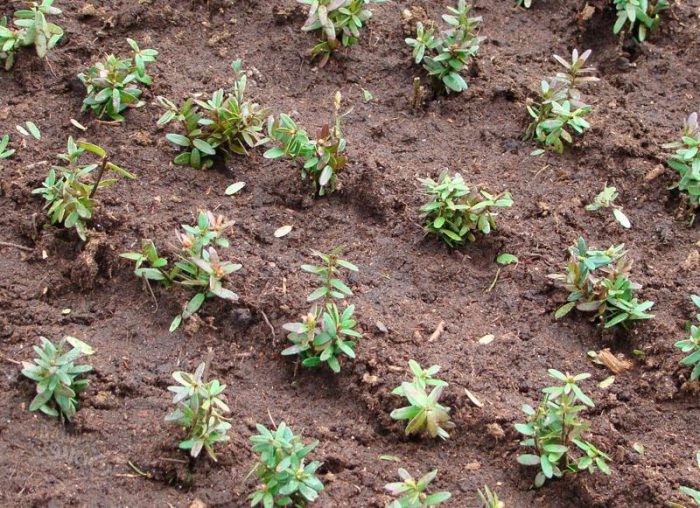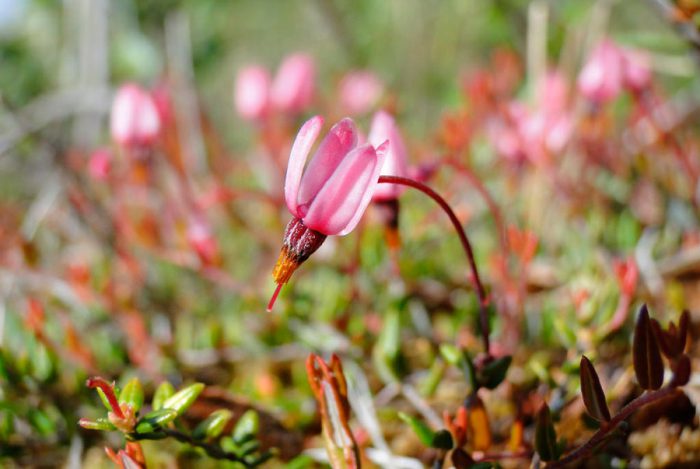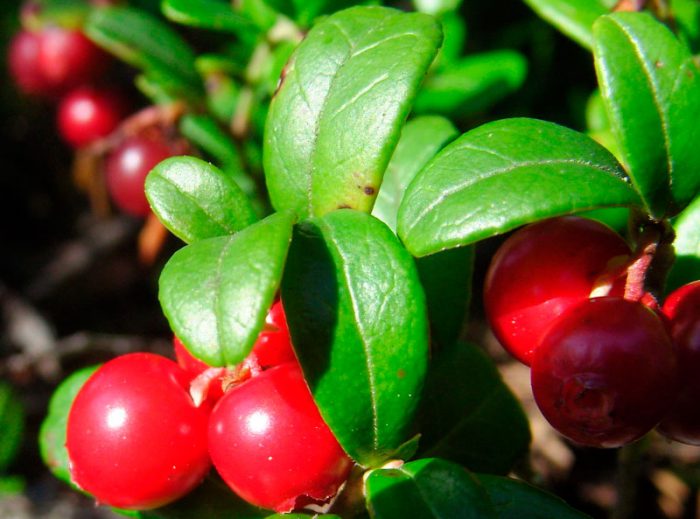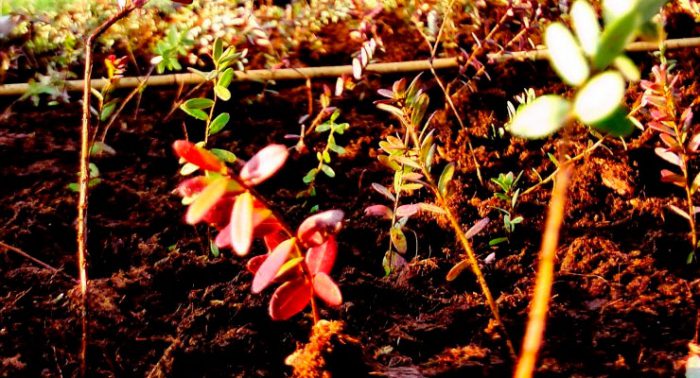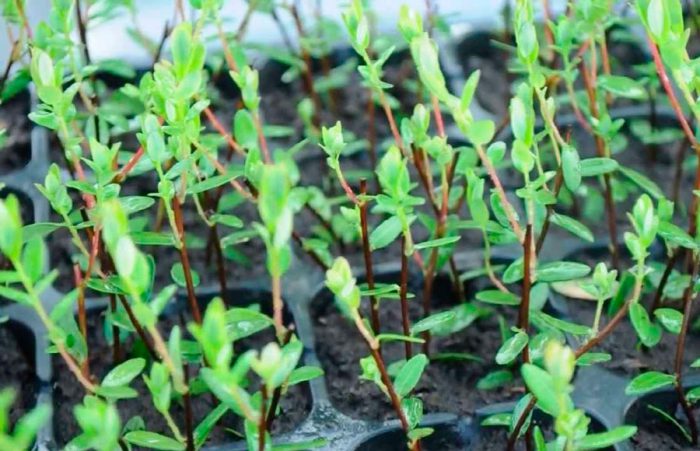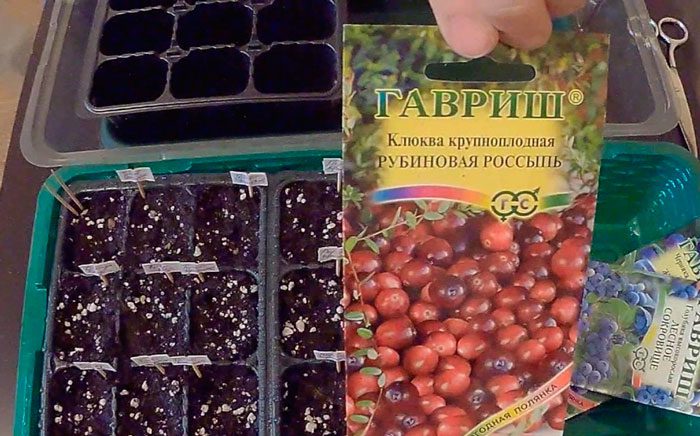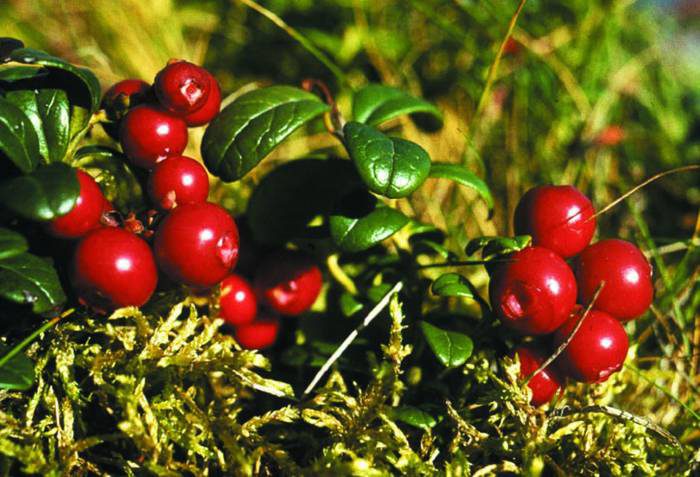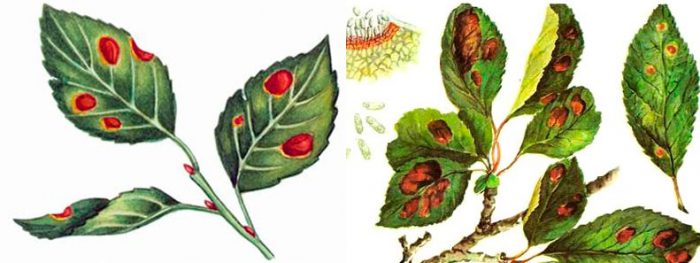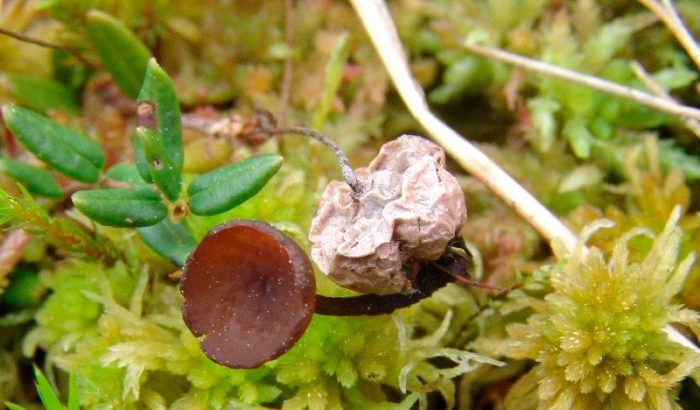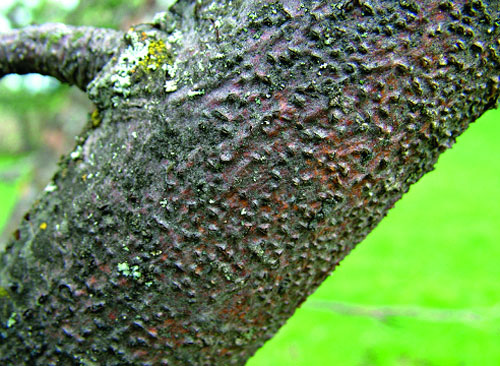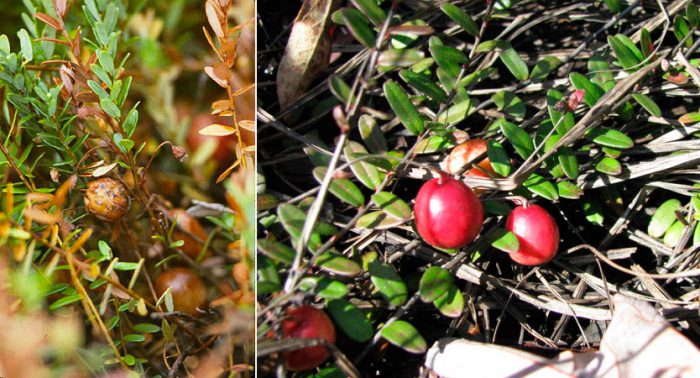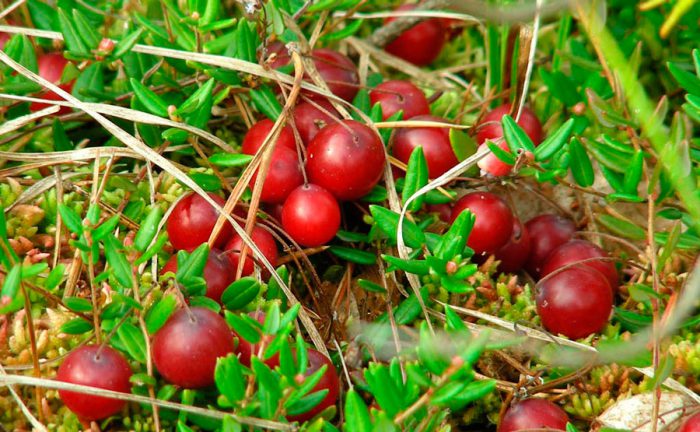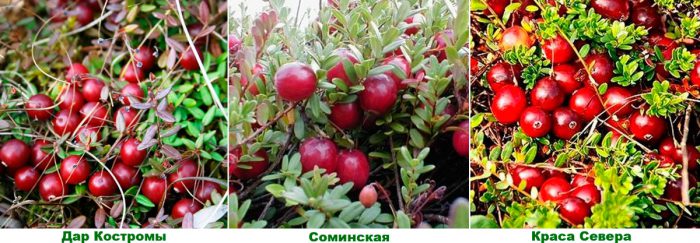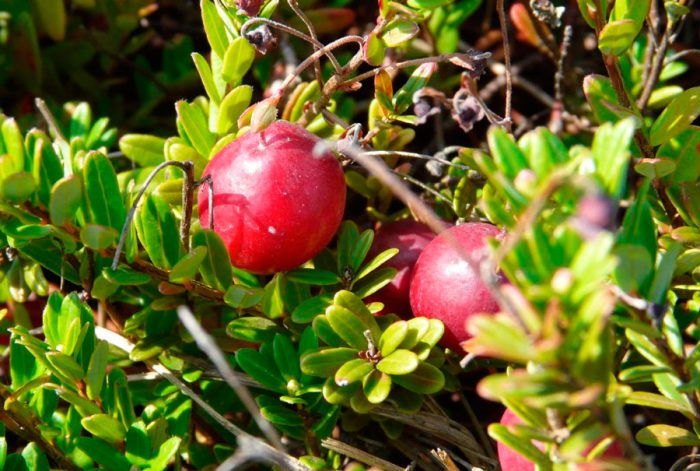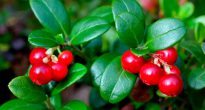Cranberry (Oxycoccus) is a subgenus of flowering plants belonging to the heather family. It is represented by evergreen creeping shrubs found in the wild in the Northern Hemisphere. In any of the cranberries, the berries are edible, and they are widely used in the food industry and in cooking. The scientific name of this plant in translation from ancient Greek means "sour berry". The pioneers of America called such a shrub the "cranberry". And in the 17th century in New England, this plant was called "bear berry", because people have seen more than once how grizzlies eat it. How the Russian name of the cranberry came about is not exactly established at the moment, but in some dialects it is called "crane" by analogy with the word cranberry, which came from America.
Under natural conditions, such a shrub prefers to grow in damp places, for example: in swamps, in sphagnum coniferous forests, along the swampy shores of various reservoirs. Gardeners cultivate only 1 species - garden cranberry.
Content
Features of cranberries
Cranberry is a creeping shrub. The height of evergreen shrubs can vary from 0.15 to 0.6 m. Core root system. Oblong or ovoid leaf plates are alternate and have short petioles. Their length is 1.5 cm, and their width is 0.6 cm. The front surface of the leaves is dark green in color, and the seamy surface is covered with a waxy bloom, which is why it has a whitish color. The wax coating protects the sheet plates from water. The shrub blooms in May or June. The color of the flowers is pale purple or pink, they are located on long pedicels. The life span of one flower is 18 days. The fruit is a red, sour ball-shaped or ovoid berry that reaches 1.6 cm in diameter.Cranberries have medicinal properties that make them very popular. However, in gardens, it can be found much less often than raspberries, red and black currants, gooseberries or strawberries. But in recent years, it has been gaining more and more popularity among gardeners, like blackberries, blueberries, strawberries and blueberries.
Planting cranberries outdoors
What time to plant
It is recommended to start planting cranberries in open ground at the beginning of the spring period immediately after the soil on the site has thawed to a depth of 8 to 10 centimeters. For planting such a shrub, an open, well-lit area with a high degree of humidity is suitable. It is better to choose a place where the soil will lie very close to the surface of the soil. If there is a stream, a pond or a small lake on the garden plot, then it is recommended to plant a shrub on the shore of such a reservoir, in this case it can be grown even in a slight shade of nearby growing trees. This plant needs acidic peat soil with a pH of 3.5–4.5, or you can use a forest substrate with sphagnum. In the event that the soil on the site is significantly different from the required one, you need to remove the top layer of earth, the thickness of which should be from 20 to 25 centimeters, and in its place should be poured a more suitable soil mixture, consisting of sand, peat, forest humus and forest land , which must be taken in a ratio of 1: 2: 1: 1. You also need to add rotted needles to this mixture.
Planting cranberries in spring
Immediately before planting in the soil, you need to make pits, the depth of which will be 10 centimeters, the distance between them should be about 20 centimeters. The finished wells should be spilled with lukewarm water. 2 seedlings are placed in one hole at once, while their height should be from 15 to 20 centimeters. Then the hole must be filled with soil, it is not necessary to tamp it. On the planted cranberries, the first fruits will grow only in the third year, while it will begin to bear fruit fully only in the fourth year. On average, 500 grams of fruit are harvested from one square meter. For the first two years, this shrub will simply be a spectacular decoration of the garden plot. Designers often decorate the landscape with very beautiful thickets of cranberries.
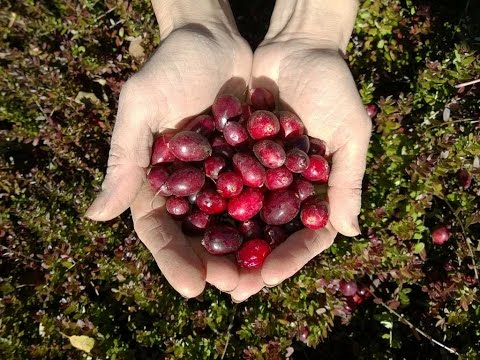

Watch this video on YouTube
Planting cranberries in autumn
Cranberry planting in autumn is not carried out. However, in September, it is recommended to start preparing a place for planting cranberries in the spring. The site for planting cranberries should first of all be fenced off, for this it is necessary to dig into the soil twenty centimeters deep into the soil at a depth of some material that does not rot, for example: plastic, slate or pieces of roofing material. This fence should protrude 0.2–0.3 m above the soil surface.
Cranberry care
Spring cranberry care
Growing cranberries is very easy, even for a novice gardener. In early spring, while the berry begins to turn green, this shrub will need thinning pruning, as well as top dressing with full mineral fertilizer. Remember to feed the plant with a not very concentrated mixture. The fact is that it is better not to feed cranberries than to overfeed. Make sure that the soil is constantly slightly damp, loosen the surface of the site regularly, and at the same time pull out the weeds. For pollination of cranberries, bees are needed, therefore, next to this shrub, you need to plant any melliferous plants, for example, oregano, savory, etc.
Summer cranberry care
In the summer, especially from mid-July to the end of August, you need to make sure that the soil in the garden is always slightly damp. As mentioned above, in order for cranberries to grow well, they need an acidic soil, therefore, to water a plant that is already 3 or 4 years old, you should use water mixed with citric acid or vinegar.In the event that the growth of the shrub is deteriorating, it must be fed by adding fertilizer to the water. Perform preventive fungicide treatments. The same drugs are sprayed with diseased cranberry bushes. Periodically loosen the surface of the soil and pull out the weeds. During the first three years, this shrub must be weeded systematically. The soil surface around the bushes that are more than three years old should be covered with a layer of mulch (coarse sand or peat chips) once every 3 or 4 years, while its thickness should be 15–20 mm.
Autumn cranberry care
In the fall, it's time to harvest. Berry picking is carried out unripe, and this time falls on September or October. Ripening of fruits occurs already during storage.
What care will the shrub need when harvest is over? In order to protect plants from pests and diseases, from winters with little snow and frosts in spring, when the outside air temperature drops to minus 5 degrees, the cranberry must be filled with water with a two-centimeter layer. Wait until this layer is completely frozen and pour in another layer of the same water. This procedure must be repeated until the bushes are completely in the ice. In the event that winters in your region are relatively mild, this shrub will only need a shelter (spunbond or spruce branches).
Cranberry processing
In order for the cranberries to grow normally, the soil must be moist all the time, and in such an environment there is a high probability of developing a fungal disease. In this regard, cranberries need periodic preventive spraying with fungicidal preparations, which are carried out several times per season. In spring, when the buds begin to swell and open, the shrub is treated with Azophos or Bordeaux mixture (1%). During the formation of buds, this plant will need 3 sprays with a break of 7 days, for this use a solution of Horus or Skor (for 1 bucket of water, take 4 grams of any of these drugs). This treatment will protect the cranberries from stains and gray mold. If this is necessary, then when the shrub has faded, it is re-sprayed against gray mold. In November, the area is sprayed with a Bordeaux mixture (1%).
How to water
Freshly planted seedlings will need daily watering for the first half month. Next, you need to ensure that the soil is always slightly damp, but not soggy. From June to May, the shrub needs to be watered not very often and in moderation, because an excess of liquid during this period has an extremely negative effect on the quality of the crop. On hot days, the plant needs cooling watering. During a prolonged drought, it is necessary to water the cranberry every day. In August – October, plants should be watered systematically. Water the cranberries so that the soil is moistened to the depth of the root layer.
Top dressing of cranberries
In order for such shrubs to grow and develop normally, they need to be systematically fed. The first feeding of freshly planted seedlings is carried out 20 days after planting. To do this, use the complex fertilizer Universal, so, for 1 square meter of the plot, ½ part of a large spoon of this nutrient mixture is taken. You will need to feed the cranberries in this way 1 time in half a month until the end of July. The next top dressing is carried out in mid-August, and then in mid-October, for this they use the Autumn fertilizer (1/3 of a large spoon per 1 square meter). In the second and third years, cranberries should be fed in the same way. During the fourth and all subsequent years, it will be necessary to reduce the amount of fertilizers, so during the growing season, the cranberries will need to be fed 6 times, taking 1/3 of a large spoonful of fertilizer for every 1 square meter.


Watch this video on YouTube
Pruning cranberries
What time to trim
Cranberries are pruned in spring, or rather, in May. During the first three years, when the intensive growth of the bush is observed, it is necessary to lay down its shape, which can be spreading or compact.
Spring pruning
In the event that you want the shrub to be compact and tall, in spring you need to cut off all creeping, thin stems that have low frost resistance, as a result, the growth of vertical branches will be stimulated. And if you want the bush to be spreading, then by pruning you need to stimulate the growth of horizontally oriented stems. When choosing the shape of the bush, it should be borne in mind that it is much more convenient to remove the fruits from a tall bush.
Autumn pruning
Pruning of this crop in the fall is done very rarely and only when there is a need for it.
Reproduction of cranberries
For propagation of cranberries, you can use the seed and vegetative method. As a rule, this plant is grown from seeds only by specialists working on the development of new varieties, because the seedling obtained in this way is not able to inherit the varietal characteristics of the parent bush. To obtain varietal seedlings for propagation, you should take green cuttings.
Propagation of cranberries by cuttings
Harvesting of green cuttings is carried out during the active growth of the stems. Cuttings in length should be 10 centimeters or more. Planting of such cuttings can be done in pots, which should be filled with sand, high peat and rotted needles, as well as in a school or directly into open soil in a permanent place. In the latter case, when planting, you should use the 7x7 centimeters scheme, this will allow the branches of the bushes to close together as soon as possible. They should be buried in the ground by 20-30 mm, which is then tamped a little. Planted cuttings need abundant watering. Until the roots appear at the cuttings, the soil should be constantly slightly damp, in some cases they will need to be watered 2 times a day. On sunny days, plants will need protection from the direct scorching rays of the sun; for this, use a cloth. As a rule, cuttings take root very quickly.


Watch this video on YouTube
Seed propagation of cranberries
You can harvest cranberry seeds yourself. To do this, select ripe fresh fruits, they need to be kneaded. The resulting mass should be rinsed with plenty of running water. Seeds that have settled on a sieve should be sown as soon as possible. Seeds stored for some time need to be stratified. For this, the box is filled with layers: one layer of moistened sand and peat (1: 4), the other - seeds. There can be several layers. The box is removed in a cool place (3-7 degrees), where there is free air access, where the seeds will stay for 10-12 weeks. Stratified seeds are sown in the spring, and freshly harvested seeds in the last summer weeks. For sowing, use containers filled with high-moor peat. The seeds are spread over the soil surface, and it is not necessary to deepen them. The seeds are covered on top with a two to three millimeter layer of sifted sand or a five millimeter layer of crushed peat. Then the crops need to be watered, the container is covered with glass on top and removed to a warm and well-lit place. Crops need systematic ventilation and moisture. Mold may appear on the surface of the soil, in which case the crops will need to be treated with a fungicide.
The first seedlings should appear in 15-30 days, as soon as this happens, the shelter must be removed, but they should be watered just as regularly. When a 4 or 5 true leaf plate begins to form in the plants, they should be dived into individual pots or into a greenhouse on the garden bed, in which case a distance of 10 centimeters must be kept between the seedlings.The duration of growing the plants will be 12 months, at which time they need to ensure systematic watering and feeding with Kemira-universal solution (1 large spoonful of water for 1 bucket of water), while 1 liter of nutrient mixture is taken per 1 square meter. When feeding, avoid getting fertilizer on the surface of the leaf plates, otherwise it may cause burns. From the second half of April to mid-July, you will need to feed the cranberries 1 time in half a month. The cover from the greenhouse must be removed in August, and in the last October days, the surface of the garden bed must be covered with a layer of mulch (peat), its thickness should be from 5 to 7 centimeters. For wintering, the bed should be covered with spunbond, putting it in 2 layers. In spring, the shelter is removed from the garden, and the plant is transplanted into a school. The duration of growing seedlings in a school is 1–2 years, then they can be planted in open ground in a permanent place. The first fruits on a shrub grown in this way will appear only 2 or 3 years after they are transplanted into open soil to a permanent place.
Diseases of the cranberry with a description
If you strictly adhere to the rules of cranberry farming, then your plant will be healthy and beautiful. But there are times when an absolutely healthy and well-groomed shrub gets sick. As soon as signs of any disease are found, it is necessary to immediately start treating the affected bush. Below will be described the diseases that this culture is susceptible to.
Snow mold
Snow mold - this disease is very dangerous, and it develops in March – April. In affected specimens, the foliage and buds turn brown-red, with a pale yellow mycelium appearing on their surface. In the last weeks of spring, the infected leaf plates change their color to ashy and die off. If nothing is done to combat the disease, the lesions begin to grow, and they merge. This can result in the death of the bush. In autumn, the entire cranberry must be treated with Fundazole solution (follow the instructions on the package). And for the winter, the plants are gradually filled with water, while they must be completely under the ice, how to do this is described in detail above.
Red spot
Fungal disease red mold leads to deformation of the stems and their subsequent death. Also, this disease affects the buds, flowers and pedicels of the plant, which is why they have a pale pink tint. The leaf plates growing from the infected buds look like miniature roses. The affected bush must be sprayed with Topsin M or Fundazol solution (2 grams of any of these drugs are taken for 1 liter of water).
Monilial burn
If wilting, drilling and drying of the tops of the stems are observed, then this means that the shrub is infected with such a fungal disease as monilial burn. In wet weather, the infected parts of the shrub turn yellow, and a bloom of conidial sporulation appears on their surface. During bud formation, buds, flowers and ovaries become infected. As a result, the buds and flowers dry out, while the affected ovaries continue to grow, but only rotten berries can grow from them. To cure the affected bush, it must be sprayed with a fungicide, for example: Ronilan, Bayleton, Topsin M, Ditan or copper oxychloride.
Phomopsis
In a shrub affected by phomopsis, drying of the ends of the stems is observed, while without noticeable signs of wilting of the bush itself. At first, the foliage turns yellow, then bronze or orange, but it does not fly around. Dirty gray spots form on the surface of the shoots, eventually becoming ulcers. Flowers and berries turn brown. In hot and dry weather, the disease develops most actively.To cure the affected specimen, in the springtime it must be sprayed with a systemic fungicide, for example, Topsin M. Before intensive plant growth begins, it can be treated with a Bordeaux mixture.
Cytosporosis
Black rot appearing on fruits is called cytosporosis. The causative agents of this disease infect the plant in the last summer weeks, and they penetrate through the small wounds on the cranberries. Treatment of the affected bush can be combined with preventive spraying of the plant in spring and autumn, while Topsin M, Bordeaux mixture or copper oxychloride are also used for treatment.
Gibber spot
Infection with gibber spot leads to the fact that foliage begins to fall off en masse, this becomes the cause of a strong weakening of the shrub. In the first days of August, small brown-red spots appear on the surface of the leaf plates, and then chlorotic shapeless spots with a dark border and a fruiting body in the center. The affected plant must be sprayed with a solution of Fundazol, Topsin M or copper oxychloride (2 grams of any specified drug is taken for 1 liter of water).
Pestalotia
When a shrub is infected with pestalotia, berries, shoots and leaf plates are affected. First, dark brown spots appear on the green parts of the plant. Then they are replaced by gray spots merging with each other, having a dark edging. A zigzag curvature of young stems occurs, as well as their drying, foliage flies. The affected bush must be sprayed with copper oxychloride.
Ascochitosis
If round specks of dark brown color appear on the surface of shoots and leaf plates, this means that the plant is infected with ascochitosis. Over time, the surface under these spots begins to crack. In the spring and autumn, the affected shrub will need to be sprayed with a solution of a fungicide (Topsin M, Fundazole or copper oxychloride).
Botrytis
Botrytis (gray rot) - this disease develops intensively in wet weather. In the affected bush, the surface of the foliage, shoots and flowers is covered with a fluffy bloom of gray color. Young shoots are not affected by Botrytis. A diseased plant must be sprayed with Topsin M, Bordeaux mixture or copper oxychloride.
Terry cranberry
Overgrowth (terry cranberry) - this disease is viral, its pathogens are mycoplasma organisms. Over time, the infected parts of the plant become similar to "witch's brooms", for example, the stems rise, the leaf plates become smaller, while they adhere very tightly to the shoots. In an infected shrub, fruiting is not observed, but if there were already ovaries on it before the infection, then they will become ugly small berries. Such a viral disease cannot be cured, in this regard, the infected cranberries should be removed from the soil and destroyed as soon as possible, otherwise the virus can spread to other bushes.
Cranberry pests
There are over 40 different pests that live on and damage cranberries. Most often, this culture suffers from the apple comma scale, cabbage scoop, black-headed lingonberry leaf roll, unpaired silkworm and heather moth.
These pests cannot cause significant harm to such a shrub. In this regard, for the purpose of prevention, it is enough just to follow the rules of cranberry farming, with special attention to the systematic weeding of the cranberry. The fact is that weeds contribute to the suppression of cranberries and the creation of favorable conditions for the life of various pests. If there are a lot of pests, then the bush must be treated with an insecticide, for example: Aktellik, Metaphos, Aktara, Karbofos, etc. It should be remembered that 4 weeks before harvesting, any treatment of the shrub should be stopped. They can be continued after all the berries have been collected from the bushes.
Types and varieties of cranberries with photos and descriptions
There are 4 types of cranberries:
- marsh cranberry, or four-petal;
- giant cranberries;
- large-fruited cranberries;
- small-fruited cranberries.
The most widespread in culture are hybrids and varieties of marsh cranberries (four-petal) and large-fruited.
Marsh cranberry (Oxycoccus palustris)
She comes from Europe. It began to be cultivated at the end of the twentieth century in Russia and the Baltic countries. Most popular varieties:
- Gift of Kostroma... This medium-early large-fruited variety has a high yield. Ribbed fruits are very large, juicy and sour, their ripening is observed in the last decade of August. The fruit has a flat-round shape, the stalk has a deep notch. Their color is cherry or dark red.
- Sominskaya... This large-fruited high-yielding variety is medium early. Asymmetrical lumpy fruits are cherry or red in color and heart-shaped. The pulp is juicy and sour.
- Sazonovskaya... Mid-ripening variety, fruit ripening is observed in early September. Medium-sized asymmetric fruits have a heart-shaped bumpy-ribbed shape and a red-violet color. The sweet and sour pulp is juicy enough.
- Beauty of the North... A late-ripening variety with a different yield. Fruit ripening is observed by the second decade of September. The oval-rounded fruits are very large, they are painted in various shades of carmine color, from dark with a reddish side to light.
- Scarlet reserved... A late-ripening variety with a high yield. The size of the globular red fruits can be medium or large. The pulp is sour and juicy.
Also, varieties such as Severyanka and Khotavetskaya are often cultivated.
Large cranberry (Oxycoccus macrocarpus)
Her homeland is North America. This species has more than 200 varieties. The most popular varieties:
- Ben Lear... An early variety with a high yield. The diameter of the rounded fruits is about 2 cm. The berries are stored very poorly, and therefore they are frozen or processed immediately after collection.
- Franklin... Medium ripening variety with disease resistance. The dark red fruits are medium in size (about 1.5 cm).
- Searles... This variety is distinguished by its yield and the fact that its fruits are stored for a long time. Dull fruits of a dark red speckled color reach 2.3 cm in diameter. The flesh is dense.
- Stevens... This variety is one of the best, it has a very high yield. The dense, oval-rounded large fruits have a diameter of about 2.5 cm and a dark red color.
- Pilgrim... This variety is very late. Large oval-shaped red-purple fruits on the surface have a yellow waxy coating. The berries are colored unevenly.
The following American varieties are also quite popular: McFarlin, Wilcox, Black Whale, Earley Black, Crowley, Earley Rear, Bergman, Washington, Wulman, Beckwith and Howes.


Watch this video on YouTube
Cranberry properties
Useful properties of cranberries
The composition of cranberry fruits includes all those useful substances that are found in various berry crops. They also contain sugars, organic acids (citric, ursolic, cinchona, benzoic, malic, chlorogenic, succinic, oleander and oxalic), vitamins (B1, B2, B5, B6, PP, K1 and C) and pectins. And these berries also contain anthocyanins, leukoanthocyanins, catechins, betaine, macro- and microelements - iron, manganese, molybdenum, copper, potassium, calcium, phosphorus, boron, cobalt, nickel, titanium, zinc, iodine, tin, chromium and silver.
Such a plant helps to improve the functioning of the digestive tract and appetite, protects the intestines and genitourinary system from infections, prevents the development of cancer, reduces the risk of atherosclerosis, and normalizes blood pressure. Such fruits are recommended to be eaten by people suffering from fever, rheumatism, vitamin deficiency or respiratory diseases.
The juice squeezed from the berries has a thirst-quenching, antibacterial and antipyretic effect, it helps to improve the functioning of the pancreas and increase mental and physical activity. The juice is used to treat coughs and burns and to cleanse wounds.
Why is cranberry dangerous?
It is strictly forbidden to eat cranberries for people with duodenal or stomach ulcers, as well as gastritis with high acidity. In the presence of liver disease, cranberries can lead to their exacerbation, so before eating it, consult your doctor. Eating such berries with caution is also necessary for those people whose tooth enamel is very weak or thinned.


Watch this video on YouTube


